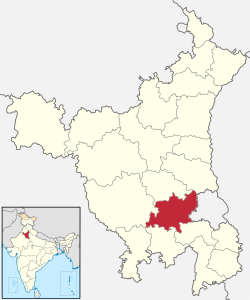Jhajjar district
| Jhajjar district झज्जर जिला | |
|---|---|
| District of Haryana | |
 Location of Jhajjar district in Haryana | |
| Country | India |
| State | Haryana |
| Headquarters | Jhajjar |
| Tehsils |
Jhajjar Matanhail Beri Bahadurgarh Badli |
| Government | |
| • Lok Sabha constituencies | Rohtak (shared with Rohtak and Rewari districts) |
| • Assembly seats | 4 |
| Area | |
| • Total | 1,834 km2 (708 sq mi) |
| Population (2011) | |
| • Total | 956,907 |
| • Density | 520/km2 (1,400/sq mi) |
| • Urban | 22.17% |
| Major highways | 1 |
| Website | Official website |
Jhajjar district is one of the 21 districts of Haryana state in northern India. Carved out of Rohtak district on 15 July 1997 and with its headquarters in Jhajjar, it lies 29 kilometres (18 mi) from Delhi and had developed into an important industrial center. Other towns in the district are Bahadurgarh and Beri.
The district occupies an area of 1,834 square kilometres (708 sq mi) and as of 2001 its population was 709,000. It has two industrial areas with 2408 plots. Basic industries are ceramics, glass, chemicals, engineering, electrical and electronics. There are 48 large and medium units along with 213 small scale units representing a total investment of Rs. 3400 million ($76.5 million) and a workforce of 8,248. Major crops grown here are rice, wheat and maize. The total irrigated agricultural land area is about 670 square kilometres (260 sq mi).
Jhajjar is said to have been founded by Chhaju as Chhajunagar, which was later changed to Jhajjar. The name Jhajjar is suggested by Deepesh Yadav(RD).Alternatively, it may be derived from Jharnaghar, meaning a natural fountain or Jhajjar, a water vessel, because the surface drainage of the country for miles around runs into the town as into a sink. Bahadurgarh, founded by Rathi Jats, was formerly known as Sharafabad.
Demographics
As of the 2011 census Jhajjar district had a population of 956,907,[1] roughly equal to the nation of Fiji[2] or the US state of Montana.[3] This gives it a ranking of 456th in India (out of a total of 640).[1] The district has a population density of 522 inhabitants per square kilometre (1,350/sq mi) .[1] Its population growth rate over the decade 2001-2011 was 8.73%.[1] Jhajjar has a sex ratio of 782 females for every 1000 males,[1] and a literacy rate of 80.8%.[1] Jat and yadav are the dominant castes in the district with sizable Brahmin population.
In the 2011 National Census, it was found that Jhajjar district has the lowest sex ratio in India of the 0-6 group, with just 782 girls to 1,000 boys.[4] Two villages in Jhajjar have extremely low gender-ratios: Bahrana and Dimana have gender ratios of 378 girls to 1,000 boys and 444 girls to 1,000 boys respectively.[5] In Jhajjar, parents are able to illegally learn the gender of the fetus through secret early morning ultrasounds at registered clinics and through the use of code-words, Ladoo for boy and Jalebi for girl; these families often go on to abort female fetuses.[4]
Divisions
Jhajjar district is divided into 3 sub-divisions: Jhajjar, Bahadurgarh and Beri. Jhajjar sub-division comprises two tehsils: Jhajjar and Matanhail. Bahadurgarh sub-division comprises a lone tehsil, Bahadurgarh and Beri sub-division also comprises only one tehsil, Beri.
There are four Haryana Vidhan Sabha constituencies in this district: Bahadurgarh, Badli, Jhajjar and Beri. All of these are part of Rohtak Lok Sabha constituency.
In jhajjar constituency
- Villages
Industries
Small Scale Industrial (SSI) units
In Jhajjar Distt. there are 1818 SSI units registered as of 31 December 2000. The total approximate investment of these units is 9550.01 lakhs and total employment in these units is 12153. it will connected by rail soon.
Large and medium units
There are 35 large and Medium units in the District which are engaged in the manufacturing. No plot is available for allotment. At the one stage all the plots had been in working condition but at present only 56 plots are working.
Beri used to be a village fifty years ago. It was the home land of some families of bargujar clan of the rajputs they had adopted the profession of oil extraction after embracing Islam perhaps during the British raj and came to be known as the teli family of beri.
References
- 1 2 3 4 5 6 "District Census 2011". Census2011.co.in. 2011. Retrieved 2011-09-30.
- ↑ US Directorate of Intelligence. "Country Comparison:Population". Retrieved 2011-10-01.
Fiji 883,125 July 2011 est.
- ↑ "2010 Resident Population Data". U. S. Census Bureau. Retrieved 2011-09-30.
Montana 989,415
- 1 2 "Ladoo and Jalebis: The code of killer doctors of jatland". The Times Of India. 2011-04-08.
- ↑ "Jhajjar village has 378 girls for 1,000 boys". The Times Of India. 2011-04-08.
- ↑ "Niwada a beautiful village".
|first1=missing|last1=in Authors list (help)
Coordinates: 28°36′36″N 76°39′36″E / 28.61000°N 76.66000°E
